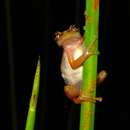Description
provided by AmphibiaWeb articles
A rather small (Males 20–23 mm, females 23–28 mm) Afrixalus from open forest in south-western Ethiopia at altitudes of about 1800 metres and above. Dark brown with a pattern in light silverish forming a triangle on top of the snout and continuing into broad dorsolateral stripes. Some specimens have a poorly to well-defined vertebral line, silver in colour and with dark margins. As with other species in the genus there can be considerable variation in the extent of the silverish pattern. Females are considerably larger than the males. Males have a gular sac with a large gular gland. The males have a few large dark asperities on the chin and gular flap, and sometimes more numerous small ones. The chest, abdomen, posterior region of the back and upper surfaces of tibia and tarsus usually have minute and often unpigmented asperities. Females sometimes have a few minute colourless asperities on the back, snout and upper eyelids. Some of the collected males have a pair of conspicuous pectoral glands and similar glandules on the inner surface of the forelimb and as a pale, somewhat thickened pad at the base of the first finger. Other males, probably collected outside the breeding season, lack pectoral glands and have inconspicuous nuptial pads.This account was taken from "Treefrogs of Africa" by Arne Schiøtz with kind permission from Edition Chimaira (http://www.chimaira.de/) publishers, Frankfurt am Main.
Distribution and Habitat
provided by AmphibiaWeb articles
Open forest in south-western Ethiopia at altitudes of about 1800 metres and above.

